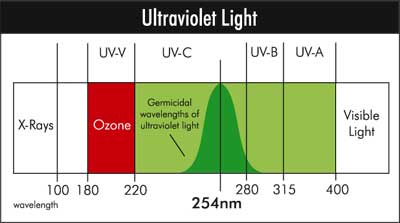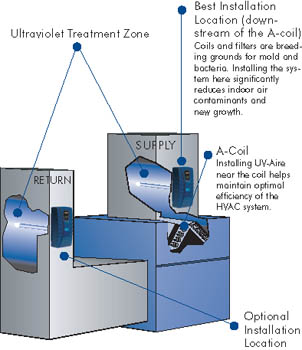UV Lamps for Mold Control
UV Lamp Systems and Bulbs
UV-AIRE Air Purification System
Indoor Air: High Concentrations of Biological Contaminants
 With tighter building construction in recent years, the quality of indoor air has declined dramatically.
With tighter building construction in recent years, the quality of indoor air has declined dramatically.
The air circulating in the ductwork of the average home or office can be concentrated with contaminants including molds, bacteria, viruses, and dust mites.
We fill our lungs up to 20,000 times each day. Over time, these contaminants can cause inflammation of the mucous membranes, upper respiratory problems, asthmatic
conditions, headaches, and flu-like symptoms.
Filtering systems offer little or no help because these airborne contaminants either pass through the filter or simply collect on the filter medium, creating a
breeding ground. Now, with the UV-Aire Air Purifying System, a solution is available to directly address the problems associated with poor indoor air quality.
The Sun: Nature's Outdoor Air Purifier
For years, scientists have known that one of the most effective air purifiers is natural sunlight. Not the light we see when we look out the window, but the invisible "C" band, ultraviolet rays that make up part of the sun's light spectrum. The sun's UV-C rays act as a natural outdoor air purification system, inhibiting the growth and reproduction of bacteria, viruses, fungi, molds, and dust mites. However, this natural process does not occur indoors. Ultraviolet radiation (UV-C) replicates the natural outdoor purification system of the sun by destroying the illness and disease-causing microbes living and multiplying in indoor air. In combination with a quality filter, it is the most effective way to reduce airborne contaminants and the health risks they represent.
 |
Facts About Indoor Air

According to the Environmental Protection Agency, the air in homes can be up to 100 times more polluted than outdoor air.1
The National Academy of Sciences Institute of Medicine reports that exposure to indoor pollutants is a key contributor to the asthma problems of this nation.2
Most allergy and asthma sources are passed from person to person through the air.
The air in a single room can contain hundreds of thousands of infectious bacteria, viruses, fungal spores, and contaminants, which can only be seen with a microscope.
Health effects may show up immediately, or after years of exposure to poor indoor air quality. These symptoms include some respiratory diseases, heart disease, and cancer. They may be severely debilitating or fatal.3
Facts About UV
The disinfection of medical equipment using UV has been a common and reliable practice.4
UV disinfection has been determined to be adequate for inactivating bacteria and viruses.5
The germicidal effects of UV light cause photochemical damage to DNA and RNA within microorganisms.6
"...ultraviolet radiation, properly integrated with heating, ventilating, and air conditioning systems, shows the most promise as a widely applicable means of air disinfection." Richard Riley, M.D.7
 |
| * The UV-V wavelength generates ozone. According to the Environmental Protection Agency, ozone can be harmful to your health. When inhaled, ozone can damage the lungs. Relatively low amounts of ozone can cause chest pain, coughing, shortness of breath, and throat irritation. Ozone can also compromise your ability to fight respiratory infections. All UV-Aire lamps are coated to block this wavelength. |
UV-AIRE Air Purification System
How The In-duct UV-Aire Works
 UV-Aire uses the energy from a specially designed, high-intensity UV-C lamp to reduce microorganisms in the entire home as they cycle through the HVAC system. Mounted inside the
ductwork, the UV-Aire sterilizes or kills most contaminants as they pass the lamp.
UV-Aire uses the energy from a specially designed, high-intensity UV-C lamp to reduce microorganisms in the entire home as they cycle through the HVAC system. Mounted inside the
ductwork, the UV-Aire sterilizes or kills most contaminants as they pass the lamp.
The process requires very little maintenance and costs just pennies a day to operate. The UV-Aire could be one of the best health and comfort investments a homeowner ever makes.
Indoor Air Treatment With UV
UV's effectiveness in killing bacteria is directly related to a microorganism's exposure time. Indoor air in a typical residential forced-air HVAC system will be recirculated 40-75
times a day. With a UV generating lamp mounted in the HVAC duct, cumulative exposure can be very effective in controlling indoor bacteria.
UV rays will also kill germs that breed in drain pans and A-coils. Properly positioned, an ultraviolet system can significantly reduce indoor air contamination and prevent the
growth of new microorganisms.
The treatment of indoor air with ultraviolet radiation has been successful in health care facilities, food processing plants, schools, laboratories and other applications. It is
safe, silent, and proven.
Since direct exposure to UV light can cause skin cancer and blindness, the most practical application of UV light in the home or office is in the main air distribution (heating
and/or air conditioning) system. As UV light will not pass through metal, glass, or plastic, a UV light can be installed in the main supply or return duct of a central heating or
air system without concern for direct exposure to eyes or skin. This is an ideal location since the air in the home or office will pass through the HVAC system up to 75 times per
day during normal operation, and as many as 150 times per day in continuous fan mode.
Filter Systems Alone Don't Solve the Problem
The majority of indoor air is conditioned by forced-air heating and cooling (HVAC) systems. Standard fiber air filters are entirely ineffective in trapping germs, as most particles are
simply too small, passing through the porous filter. New, high efficiency style filters will only capture airborne bacteria down to a certain size. These high efficiency filters
are nominally effective, trapping small airborne contaminants on the filter, creating a breeding ground where germs can continue to grow and multiply.
HVAC systems are a dark and damp breeding ground for mold and bacteria, particularly at the system filter and air conditioning A-coil. The buildup of matter on the A-coil and
filter can significantly reduce the efficiency of the appliance by constricting and reducing air flow. This means increased cost to the homeowner in addition to the risk of airborne
pollutants.
UV-AIRE Air Purification System
How Much UV Energy is Required to Kill Bacteria?
Most, if not all bacteria can be destroyed by the use of UV light. The main factors in disinfection are the amount of UV power the lamp produces and the length of time the bacteria is
exposed to the UV light source.
The energy required to kill microorganisms is a product of the UV light's intensity and exposure time. This energy is measured in microwatt seconds per square centimeter.
Intensity x Exposure Time = microWatt seconds/cm2
Table 1 lists the amount of UV energy (measured in µW-sec/cm2) necessary to destroy various bacteria.
Independent Lab Testing
Independent lab testing of the UV-Aire shows that in a single-pass air flow test, one 18-inch UV-Aire lamp can reduce levels of Serratia Marcescens (a typical bacteria) by 93%, while a
two lamp system can reduce by 99%.1
The calculated average UV energy output levels of a single UV-Aire lamp in an 18-inch square duct is 2,608 µ-sec/cm2 and 6,186 µ-sec/cm2 for a two lamp system. The
6,186 is comparable to the 99% energy required for Serratia Marcescens. It can be seen that there is a direct correlation between the UV-Aire UV lamp output and the observed kill
rates in the lab.
Bird Flu Virus (Avian Flu) |
| The Bird Flu Virus is a type of Influenza. Since the kill rate for the influenza virus is 6,600 microwatts of UV energy, it is reasonable to conclude that the Bird Flu virus can be reduced or eliminated by 6,600-10,000 microwatts. |
| UV dose required for the de-activation of various microbes | |
| Bacteria | UV Dose |
| Serratia Marcescens | 6,160 |
| Legionnella bozemanii | 3,500 |
| Legionnella micdadei | 3,100 |
| Mycobacterium tuberculosis | 10,000 |
| Salmonella enteritidis | 7,600 |
| Salmonella typhi (Typhoid Fever) | 7,000 |
| Streptococcus hemolyticus | 5,500 |
| Virus | UV Dose |
| Influenza | 6,600 |
| Infectious Hepatitis | 8,000 |
| Adeno Virus Type III | 4,500 |
| Rotavirus | 24,000 |
| Mold | UV Dose |
| Aspergillus amstelodami | 77,000 |
| Mucor Mucedo | 77,000 |
| Penicillium chrysogenum | 56,000 |
| Yeast | UV Dose |
| Baker's Yeast | 8,000 |
| Brewer's Yeast | 13,200 |
| UV dose is measured in microwatt seconds per centimeter squared (µ-sec/cm2). The information presented is intended to give the reader a general idea of how UV disinfects, based upon various credible resources. We do not guarantee its accuracy in any way. | |
| Distance from Lamp | Intensity Factor |
| 0 | 354 |
| 1" | 127 |
| 2" | 69 |
| 4" | 32 |
| 6" | 20 |
| 8" | 14 |
| 10" | 14 |
| 15" | 6 |
| 20" | 4 |
| 25" | 3 |
| 30" | 2 |
| 35" | 1.4 |
| 39.97" | 1 |
| UV lamp intensity is rated at a distance of one meter. To determine the intensity of ultraviolet radiation at different distances from the lamp, multiply the
intensity of the lamp by the intensity factor shown in the models and specifications chart. Example: To determine the ultraviolet intensity of the UV-18 at a distance of six inches, multiply 73 by 20 to yield 1460 µ-sec/cm2. | |
Correlating The Lab Test With Other Bacteria
Use the chart below to estimate the effectiveness of the UV-Aire with other bacteria.
Harder-to-kill bacteria and molds require greater energy or exposure time to be as effective. For example, 99% reduction of Rotavirus requires 24,000 µ-sec/cm2 of UV energy versus 6,600 µ-sec/cm2 for Influenza virus (see table below). This means that Rotavirus spores are five times more resistant than Influenza. Consequently, spores will require five times the UV output energy from the lamp or five times greater exposure time. For practical purposes, we recommend trapping the spores in a high efficiency filter downstream of the UV-Aire which can be irradiated continuously with the UV-Aire lamp.
UV-AIRE Air Purification System
 |
STANDARD MODELS UV-12, UV-18, UV-28, UV-12HP, UV-18HP, UV-28HP |
|
 |
DUAL LAMP MODEL UV-18X |
|
PLEASE NOTE: U.P.S. DOES NOT OPERATE ON THE WEEKEND, SO IF YOU ORDER A NEXT DAY AIR PART ON FRIDAY, YOU WILL NOT GET IT ON THE WEEKEND! WE CAN'T BE RESPONSIBLE FOR THE U.P.S. DELIVERY SCHEDULES. IF YOU NEED A PART FOR THE WEEKEND, PLEASE ORDER BY THURSDAY BEFORE NOON MOUNTAIN TIME.
uv light mold
mold control
uv lights
uv light
black mold control
uv light for mold
ultraviolet lights
ultraviolet bulbs
germicidal uv lamp
germicidal uv light
uv bulbs
ultraviolet lights for air conditioning
ultraviolet lamps
mold and mildew control
mold control products
uv air purifier
germicidal uv lights
mold and mildew
uv light kill mold
mold removal
test for mold
germicidal uv bulbs
germicidal uv lamps
germicidal uv bulb
ultravation uv lights
uv light kills mold
ultraviolet lamp
ultraviolet air purifier
lamp mold
mold uv light
killing mold
germicidal ultraviolet light
uv light air cleaners
kill mold
ultraviolet light for air conditioners
uv air filter
uv air purifiers
uv bulb
ultraviolet air purifiers
uv light air conditioning
black mold removal
uv lamps
uv light germicidal
mold treatment
uv air cleaners
for mold remediation
uv lights for ac
uv air cleaner
black mold treatment
mold and mildew treatment
uv air filters
remove mold
central air systems
uv light air purifier
uv lamp
uv air cleaning
germicidal uv cleanser
black mold
central air
basement mold removal
ultraviolet air cleaner
uv lights germicidal
ultraviolet air purification
mold clean up
uv light air cleaner
mold killing products
air purifiers for mold
air purifier uv light
germicidal uv
ultraviolet light for ac
kills mold and mildew
uv light sterilization
air purifier mold
ultraviolet air cleaners
uv air
ultraviolet air
uv germicidal lamps
hvac uv light
ultraviolet lighting
mold removal mold removal
germicidal ultraviolet
uv light air conditioner
ozone generator
ultraviolet germicidal lamp
ac uv light
mold
ultramax uv light
uv lamp germicidal
mold remediation
killing mold and mildew
mold and mildew symptoms
air conditioning mold removal
indoor uv light
ultraviolet light
black mold remediation
ultraviolet germicidal lamps
mold and mildew removal
uv lamps for home
mold cleaning
air cleaner uv




